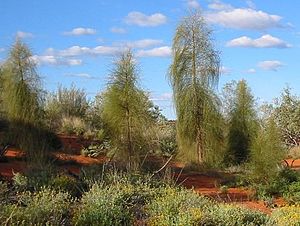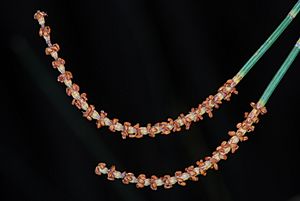Sheoak facts for kids
Quick facts for kids Sheoak |
|
|---|---|
 |
|
| Allocasuarina decaisneana in Central Australia | |
| Scientific classification |
|
| Kingdom: | Plantae |
| Clade: | Tracheophytes |
| Clade: | Angiosperms |
| Clade: | Eudicots |
| Clade: | Rosids |
| Order: | Fagales |
| Family: | Casuarinaceae |
| Genus: | Allocasuarina L.A.S.Johnson |
| Type species | |
| Allocasuarina torulosa (Aiton) L.A.S.Johnson |
|
| Species | |
|
61 species; see text. |
|
Allocasuarina is a group of trees and shrubs. They belong to the flowering plant family called Casuarinaceae. These plants are special because they are only found in Australia. Most of them grow in the southern parts of the country. People often call them sheoaks or she-oaks.
Sheoaks are very similar to another group of trees called Casuarina. Scientists tell them apart by looking at their seeds and cones. Casuarina seeds are dull and grey or yellow-brown. Their cones have thin, long parts. Allocasuarina seeds are shiny and red-brown to black. Their cones have thicker, rounder parts, often with a spiky bump.
How Sheoaks Grow
Sheoaks are trees or shrubs known for their long, jointed branches. These branches act like leaves and are called cladodes. They look a bit like pine needles, even though sheoaks are flowering plants. The real leaves are tiny scales around each joint of the branch.
When these cladodes fall, they create a thick, soft mat on the ground. This mat stops other plants from growing underneath the sheoaks. This makes sheoak forests very quiet and peaceful.
Sheoaks also have spiky "cones." These are actually woody fruits, not like the cones on pine trees. They are about the size of an acorn. Male sheoak trees do not produce these fruits. Sometimes, people call male trees "heoaks."
Just like some other plants, sheoak roots have special bumps called nodules. These nodules contain tiny bacteria that help the plant get nitrogen from the air. Nitrogen is a very important nutrient for plants. This, along with their special branches that save water, helps sheoaks grow well in poor soil and dry areas. However, sheoaks do not handle bushfires as well as eucalypt trees.
Scientists have found fossils of plants similar to sheoaks. These fossils date back to the time when the supercontinent Gondwana existed.
Why Sheoaks are Useful
The wood from sheoaks is very hard and has a beautiful texture. This makes it popular for people who do wood-turning, which is shaping wood on a spinning machine. Sheoak wood is also great for firewood because it burns with very little ash.
Sheoaks are often used to help stop erosion. They can grow strong, deep root systems in poor or sandy soils. Their fallen "needles" also cover the ground completely. This makes them good for stabilizing soil in areas where the ground might wash away, like on sand dunes. Sheoaks are also grown as ornamental shrubs in gardens. However, the mat of fallen "needles" can sometimes be a lot to clean up.
List of Sheoak Species
There are many different kinds of Allocasuarina species. In fact, there are 61 known species! Some examples include:
- Allocasuarina acuaria
- Allocasuarina acutivalvis
- Allocasuarina brachystachya
- Allocasuarina campestris (tamma)
- Allocasuarina crassa (Cape Pillar sheoak)
- Allocasuarina decaisneana (Desert oak)
- Allocasuarina decussata (Karri oak)
- Allocasuarina inophloia (Hairy oak)
- Allocasuarina littoralis (Black sheoak)
- Allocasuarina torulosa (Forest sheoak)
- Allocasuarina verticillata (Drooping sheoak)
See also
 In Spanish: Allocasuarina para niños
In Spanish: Allocasuarina para niños



